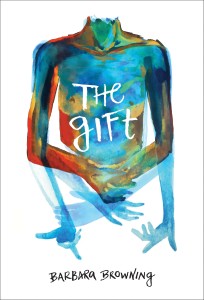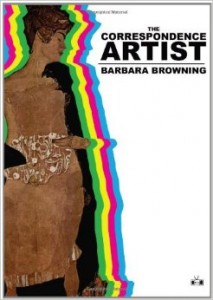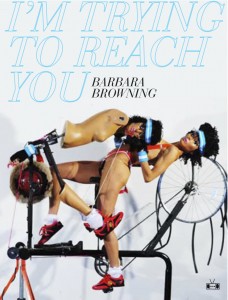Barbara Browning came to life before me on a chilly gray Sunday, as I lay under the bedsheets, dressed in wool for warmth. I’d just finished Sheila Heti’s How Should A Be?, a book that left me feeling a little bit empty and angry. I was in the mood to read more, it was a day made for reading, and so I followed it with Tove Jansson’s Fair Play, a book about artists and writers performing their art on the pages, through video and film.
And then I remembered a book sitting idle on the shelves of my iPad waiting to be read: Browning’s book, I’m Trying To Reach You, about an ex-dancer who, following the breadcrumb trail of related videos on YouTube following the deaths of Michael Jackson, Pina Bausch, and Merce Cunningham, finds himself engulfed in a mystery of internet connections, leading him to become an unwitting spy into a secret and seemingly dangerous world of code and semaphore, messages tapped like Morse code with the rubber soles of a dancer’s sneakers. Browning is a dancer in life, and a character in her own book: the mysterious dancing woman discovered by narrator Gray Adams. Browning herself appears in images throughout the book, stills from videos that live on YouTube as well.
Wait, I thought. So she’s real?
Barbara Browning came to life before me on a chilly gray Sunday. Suddenly as the pages turned it was as if the book was really happening; in the same world in which I lay on my bed, my hair coming undone, my hands a little bit cold — things I know or thought to be real — there beneath my hooked finger as it hovered over the iPad was a dancer on YouTube, dancing in a room, the paintings on the wall just as they were described in the book. She exists. Not just for Gray Adams, but for me as well. Browning’s performance there on the screen changes my perception of reality, and therefore changes my performance as a reader. It’s one thing to read about real life New York landmarks — the Soviet-style NYU buildings on West 3rd street, the Bleecker Street Morton Williams — but to create a living plot piece out of a book: it’s as if this really happened.
Through the simple act of drawing the text outside of the pages of a book, the author has taken full control of the reader. This is your reality now.
This has happened to me before, I thought, in another book I loved: Chris Kraus’s I Love Dick. Kraus’s book is inspired by real events, something I knew going in. I’d read that book in bed too, and as I read I reached for my iPad to read more about these characters — these real people, drawing them out of the words on the page to find a more tangible place for them in my reality. And the world became a different place. From Eileen Myles’s foreword to that book:
[W]hen I Love Dick came into existence, a new kind of female life did too. By writing a total exegesis of a passion, false or true, she is escorting the new reader into that world with her.
False or true. Kraus did the same thing to me as Browning was doing now, challenging me to make her reality mine, and I couldn’t get enough of it.
THIS. THIS is what I want more of.
I wanted more reality in narrative. I wanted the characters to be willing to casually say “fuck” and “omg” on the page of a book not to get a rise but because this is how we really speak. I wanted to read about academics doing something else (having affairs, writing dirty emails, browsing YouTube) to avoid doing the work they’re supposed to be doing. Like so many of us do. Like you might be doing now.
I loved the realness of these women. Kraus taking the reins in her relationship and driving the sled into the tree; Browning’s imperfect and somewhat introverted dance. Here in the latter half of my thirties, I needed these women to be real: this is the age when we realize we’re sick of having womanhood invented and reinvented for us. What good is a purely invented woman to a real one anymore?
* * *
I spend a lot of time as a reader thinking about a machine that doesn’t exist. It’s a recommendation machine — huge, the size of those old computers that once filled entire rooms, it must be — that would take into account everything you currently loved in the world — not just books or music, but tastes and textures and the color of lipstick you are wearing and the way the light hit the wall of your office just so — and spit out a recommendation for the next song you should listen to, the next coat you should wear, the next book you should read. Mostly that: the next book.
I’ll read something I love, and I’ll crave something more of exactly what that book was, the feeling I had while reading it, the way the light looked to me as I turned the last page. But most of these recommendation machines are only good at viewing “genre” from one angle: the Pandora effect, analyzing a few elements of the book (female narrator, plot-driven, modern setting) and often coming up with a book that is similar but doesn’t quite cut it. It doesn’t have the same feeling I wanted.
These machines have no idea what I’m going through as I read. They don’t understand my experience as a reader. My reality. The fact that I read this book in bed, and that one lying in the grass of a park, this one while my hair was coming undone and my hands felt cold. But what if the machine understood these things? What if the books themselves influenced our experience?
What if it’s the experience itself I crave?
* * *
I can’t help but pay attention to where and how I read things now. The experience. A similar gray Sunday, a different gray continent: in England, laid up with a cold, I picked up Dodie Bellamy’s the buddhist and read about another real woman with another infatuation with a man. Then, seeking the same, I returned to Ohio and picked up Barbara Browning’s other novel, The Correspondence Artist, another book about a different woman with another infatuation for a different man. Or a woman. Or another man. We don’t really know for sure.
I read the whole chapter introducing narrator Vivian’s paramour as a musician from Mali in the bath, with the water quickly growing cold. As I read, I thought about the bath water, how as it grew colder, it reached the same temperature as my body, until I couldn’t feel it anymore, and the only way I knew the water was there was by moving my hand. Browning has an amazing trick of compelling you to move your hand through the bathwater, or hypnotizing you into holding it absolutely still. Now it’s real; now it isn’t.
It’s disturbing in a way to think of these very real characters as illusions. Browning herself talks about the difficulty of portraying real people in fiction. And as I said before, what good is an invented woman to a real one? But aren’t we illusions to other people? To ourselves? When we put on lipstick, when we play dress up, when we feign interest in a topic out of politeness? How much of our relationships with other people are things we invent entirely in our heads? Most of them? All?
How is the fiction of our reality any different from the reality of fiction? And why should our emotional reaction to one be any different from the other? Isn’t all of it the fantasy of perception? Or deception?
In an email to her paramour, Vivian writes: “The ripped up letter was the only part of the poem that was completely fictional, but when I read it to myself, that was the line that made me cry.” Elsewhere, she writes that “it’s funny, writing about Tzipi, I began to fall in love with her. Which I can do, because she’s a fictional character.” I understand this all too well: the very real emotion we feel over something unreal.
About a year ago I went with my family to see the George Clooney movie The Descendants. Afterwards, we were discussing the sadness of a fictional death in the film, over Indian food. “I don’t understand why people enjoy making themselves that sad over something fictional,” my dad said between bites of his lamb korma. “I think it’s because it’s the only way some of us can process emotions we feel in real life that we don’t know how to access, or even emotions we might never get to feel in real life but need to experience.”
I don’t know where that came from. I don’t know if I was right; it seemed right at the time.
* * *
The Correspondence Artist was still on my bedside table, a bookmark halfway through, when my mother called me and told me that my grandmother was dying. I tucked the book into my backpack and drove 30 miles north to sit at her bedside, I even pulled the book out as we sat by the fire waiting, but wasn’t able to process the words on the page. After her death, when we were sleep deprived and philosophical, we went looking in her bedroom for remembrances to pass along to my cousins, I found a Muriel Spark book on her bedside table, Memento Mori, a book she must have read years ago, at the beginning of her Alzheimer’s. She had underlined several passages in the book, mostly ones referring to dementia. One passage she underlined, however, reminded me instantly of Browning:
“Because,” she said, “the art of fiction is very like the practice of deception.”
I can’t say in particular in what way my grandmother identified with that line, or why she felt the need to underline it, but in my narrative, it was a reminder that whether fiction or deception, whether a real death or a fictional one, a real relationship or an imagined one, the emotional reaction can be so very real all the same. The line brought Barbara Browning back into the room with me, and with her the idea that even as I was being drawn further and further away from the truth, I was coming closer and closer to something emotionally salient.
At its crux: it’s okay to have an emotional reaction to fiction. It’s okay to feel deceived and still feel an honest and very real reaction to something that never was really there.
***
I spent the month of October at a writer’s residency in a port town in Latvia. Most days the rain lashed the windows and we remained tucked inside cooking pelmeni with sour cream and dill in the communal kitchen, offering to share a bottle of wine with fellow writers. At one of these dinners, I had a conversation with two Estonian television writers about loneliness and the internet. Spurred by an article we’d just read and shared about a jacket someone had designed that “hugged” you tighter for every like you received on Facebook, we wondered if the internet made us feel more or less lonely, if its projection of simulated company was little more than an illusion, and once that illusion bursts, what happens then? Fiction is very like the practice of deception. Or to give the moment to Browning: I think being in love is when you allow yourself to enter into a state of fiction.
I thought of the social media jacket conversation months later as I read I’m Trying To Reach You. Gray Adams is far away from everyone he loves, and seeking connection to reality — some sort of tether in his unmoored world — through comments left by strangers on a YouTube video posted by a stranger. It’s as if he’s willing these strangers into existence, because if they did not exist, he would be alone.
If they did not exist, we would be alone. So it is as well with Vivian in The Correspondence Artist, only in a different direction: she can fall in love with them because they are fictional manifestations. They may not exist, but because she has compelled them to exist, they are good company.
Not long ago I decided that I’d never write a novel because there was too much amazing stuff in life that needed to be written down, too many wonderful characters; why bother creating fictional characters when reality has such amazing ones?
But now I can see it differently as I sit here, hands cold, hair coming undone, or so I think: what does it matter, real or fiction, true or false, if the emotional reaction is there just the same?





